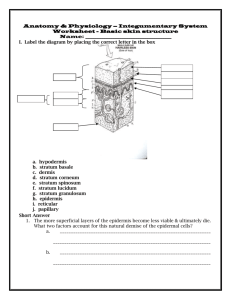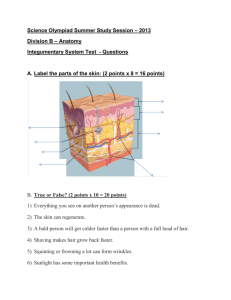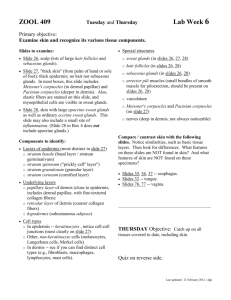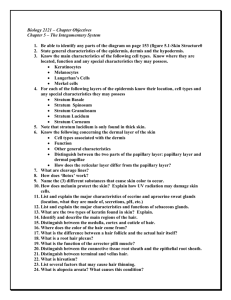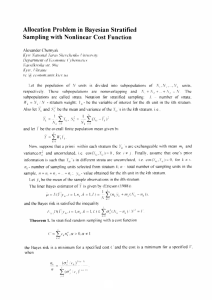Chapter 5 Quiz 1
advertisement
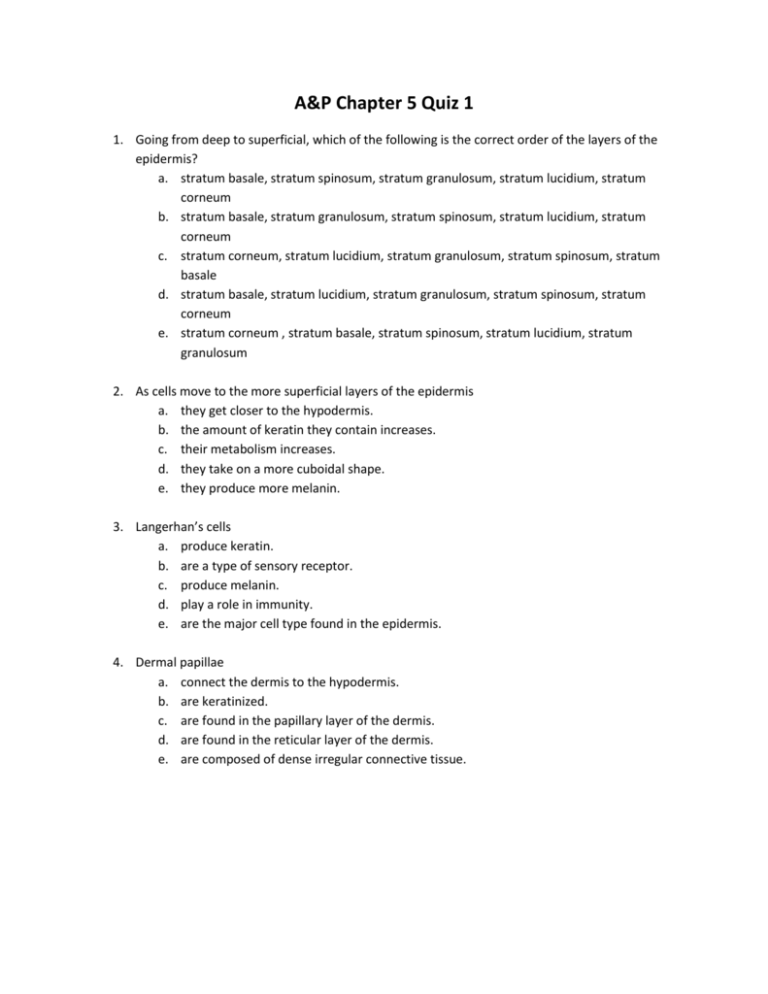
A&P Chapter 5 Quiz 1 1. Going from deep to superficial, which of the following is the correct order of the layers of the epidermis? a. stratum basale, stratum spinosum, stratum granulosum, stratum lucidium, stratum corneum b. stratum basale, stratum granulosum, stratum spinosum, stratum lucidium, stratum corneum c. stratum corneum, stratum lucidium, stratum granulosum, stratum spinosum, stratum basale d. stratum basale, stratum lucidium, stratum granulosum, stratum spinosum, stratum corneum e. stratum corneum , stratum basale, stratum spinosum, stratum lucidium, stratum granulosum 2. As cells move to the more superficial layers of the epidermis a. they get closer to the hypodermis. b. the amount of keratin they contain increases. c. their metabolism increases. d. they take on a more cuboidal shape. e. they produce more melanin. 3. Langerhan’s cells a. produce keratin. b. are a type of sensory receptor. c. produce melanin. d. play a role in immunity. e. are the major cell type found in the epidermis. 4. Dermal papillae a. connect the dermis to the hypodermis. b. are keratinized. c. are found in the papillary layer of the dermis. d. are found in the reticular layer of the dermis. e. are composed of dense irregular connective tissue. 5. Squamous cell carcinoma typically arises from a. melanocytes. b. Merkel cells. c. cells of the stratum spinosum. d. cells of the stratum granulosum. e. cells of the stratum basale. 6. First-degree burns a. are characterized by destruction of nerve endings. b. are characterized by localized redness. c. are characterized by blistering. d. are characterized by loss of body fluids. e. are also called partial-thickness burns. 7. Melanoctyes a. are a type of cell through which filtration easily occurs. b. are primarily found within the reticular layer of the dermis. c. are a type of sensory receptor. d. play a role in immunity. e. are primarily found within the stratum basale. 8. The type of skin glands found in the ear are called a. ceruminous glands. b. sebaceous glands. c. eccrine sweat glands. d. holocrine glands. e. apocrine sweat glands. 9. The reticular layer of the dermis is primarily composed of a. hyaline cartilage. b. mesenchymal connective tissue. c. dense irregular connective tissue. d. areolar connective tissue. e. dense regular connective tissue. 10. Seborrhea is caused by a. puberty. b. overactive sebaceous glands. c. underactive sebaceous glands. d. overactive eccrine sweat glands. e. underactive eccrine sweat glands. 11. The primary function of hair on human skin is to a. makes us look larger and more intimidating when we are frightened. b. act as lubricant. c. regulate heat loss from the body surface. d. sense insects on the skin. e. protect the skin from UV radiation. 12. Burns are classified on the basis of the a. body part burned. b. depth and extent of the damage. c. sex and age of the individual burned. d. cause of the burn. e. rule of eights. 13. Acne is caused by a. eating chocolate. b. inflammation of sebaceous glands. c. inflammation of eccrine sweat glands. d. inflammation of ceruminous glands. e. inflammation of apocrine sweat glands. 14. The ABCD rule is used to a. distinguish thick skin from thin skin. b. look for melanoma. c. measure the depth of a burn. d. determine if the skin is producing sufficient vitamin D to meet the bodies needs. e. measure the extent of a burn. 15. Male pattern baldness is a response to a. testosterone. b. poor nutrition. c. insufficient keratin production. d. excessive exposure of the skin to UV radiation. e. estrogen. A&P Chapter 5 Quiz 1 Answer Key 1. a 2. b 3. d 4. c 5. c 6. b 7. e 8. a 9. c 10. b 11. d 12. b 13. b 14. b 15. a
